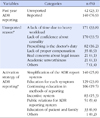Abstract
Purpose
The aim of this study was to identify the relationship between nurses' knowledge of adverse drug reactions (ADR), attitudes, and monitoring practices and to establish an effective ADR reporting system and provide baseline data for its activation.
Methods
The participants in this study were chosen by convenience sampling and included 182 nurses working at major general hospitals that operate a Regional Drug Safety Center. Data were collected from June 1 to 12, 2015 and analyzed using Cronbach's α, descriptive statistics, independent t-test, one way ANOVA, Pearson correlation coefficient and stepwise regression with the SPSS program.
Results
The nurses' average score for knowledge was 7.62 points, for attitude, 41.04 points and for monitoring practices, 34.22 points. ADR monitoring practices positively correlated with knowledge (r=.19, p=.011), attitude (r=.41, p<.001), drug performance competency (r=.54, p<.001), and drug education satisfaction (r=.54, p<.001). Drug performance competency, drug education satisfaction, and attitudes explained 42.0% of the ADR monitoring practices (Adj R2=.42, F=43.95, p<.001).
Figures and Tables
References
1. Edwards IR, Aronson JK. Adverse drug reactions: Definitions, diagnosis, and manage-ment. Lancet. 2000; 356(9237):1255–1259. DOI: 10.1016/S0140-6736(00)02799-9.
2. Davies EC, Green CF, Taylor S, Williamson PR, Mottram DR, Pirmohamed M. Adverse drug reactions in hospital in-patients: a prospective analysis of 3695patient-episodes. PLoS One. 2009; 4(2):e4439. DOI: 10.1371/journal.pone.0004439.
3. Emst FR, Grizzle AJ. Drug-related morbidity and mortality: Updating the cost-of-illness model. J Am Pharm Assoc. 2001; 41(2):192–199.
4. Kyung EJ, Rew JH, Oh MN, Kim EY. A survey on attitude and awareness of health-care professionals regarding pharmacovigilance system and experience for adverse drug reaction (ADR) from a single university hospital. Korean J Clin Pharm. 2013; 23(4):256–268. http://www.earticle.net/article.aspx?sn=210494.
5. Choi D, Choi MS, Ko AR. Current status of pharmaceutical safety management in Korea. J Korean Med Assoc. 2012; 55(9):827–834. DOI: 10.5124/jkma.2012.55.9.827.
6. Korea Food and Drug Administration. Pharmacovigilance research network. Standard operation procedures for pharmacovigilance research network regional pharmacovigilance centers. Seoul: Pharmacovigilance Research Network;2011.
7. Korea Institute of Drug Safety & Risk Management. Introduction of RPVC [Internet]. cited 2015 February 25. Available from: https://www.drugsafe.or.kr/iwt/ds/en/community/EgovIntroductionPvCenter.do.
8. Park BJ. Drug utilization review. J Pharmacoepidemiol Risk Manag. 2008; 1:13–19.
9. Kim MY. Nurses' monitoring of adverse drug reactions: Focusing on awareness of, attitude toward and knowledge about adverse drug reaction [master's thesis]. Seoul: Seoul National University;2012.
10. De Angelis A, Colaceci S, Giussti A, Vellone E, Alvaro R. Factors that condition the spontaneous reporting of adverse drug reactions among nurses: an integrative review. J Nurs Manag. 2015; May. 14. DOI: 10.1111/jonm.12310.
11. Sacilotto K, Bagheri H, Lapeyre-Mestre M, Montastruc JL, Montastruc P. Adverse drug effect notifications by nurses and comparison with cases reported by physicians. Therapie. 1995; 50(5):455–458.
12. Valente S, Murray L, Fisher D. Nurses improve medication safety with medication allergy and adverse drug reports. J Nurs Care Qual. 2007; 22:322–327. DOI: 10.1097/01.NCQ.0000290413.04522.0b.
13. Ulfvarson J, Mejyr S, Bergman U. Nurses are increasingly involved in pharmacovigilance in Sweden. Pharmacoepidemiol Drug Saf. 2007; 16:532–537. DOI: 10.1002/pds.1336.
14. Ko MS. The status of drug side effects and ADR monitoring practice activation. J Korea Contents Assoc. 2012; 10(2):12–16.
15. Lepakhin VK. Safety of medicines: A guide to detecting and reporting adverse drug reactions: Why health professionals need to take action. Geneva: World Health Organiza-tion;2002.
16. Kim HK. Adverse drug reaction monitoring and reporting. J Korean Soc Health Syst Pharm. 2004; 21(4):357–370.
17. Lee YE. Medication activity frequency, perceived competency and educational needs among nurse and nursing students [master's thesis]. Daejeon: Eulji University;2012.
18. Jung SY, Kim YH, Kang IS, Son HM. The perception of nurses and physicians regarding medication errors and reporting. Glob Health Nurs. 2013; 3(2):54–63.
19. Mendes D, Alves C, Batel Marques F. Nurses' spontaneous reporting of adverse drug reactions: expert review of routine reports. J Nurs Manag. 2014; 22(3):322–330. DOI: 10.1111/jonm.12003.
20. Gabe ME, Davies GA, Murphy F, Davies M, Johnstone L, Jordan SUE. Adverse drug reactions: treatment burdens and nurseled medication monitoring. J Nurs Manag. 2011; 19(3):377–392. DOI: 10.1111/j.1365-2834.2011.01204.x.
21. Santosh KC, Tragulpiankit P, Edwards IR, Gorsanan S. Knowledge about adverse drug reactions reporting among healthcare professionals in Nepal. Int J Risk Saf Med. 2013; 25(1):1–16. DOI: 10.3233/JRS-120578.
22. Figueiras A, Herdeiro MT, Polonia J, Gestal-Otero JJ. An educational intervention to improve physician reporting of adverse drug reactions: A cluster-randomized controlled trial. JAMA. 2006; 296(9):1086–1093. DOI: 10.1001/jama.296.9.1086.
23. Cosentino M, Leoni O, Oria C, Michielotto D, Massimo E, Lecchini S, et al. Hospital-based survey of doctors' attitudes to adverse drug reactions and perception of drug-related riskfor adverse reaction occurrence. Pharmacoepidemiol Drug Saf. 1999; 8:Suppl 1. S27–S35. DOI: 10.1002/(sici)1099-1557(199904)8:1+<s27::aid-pds407>3.0.co;2-q.




 PDF
PDF ePub
ePub Citation
Citation Print
Print







 XML Download
XML Download